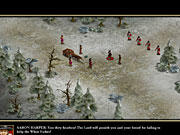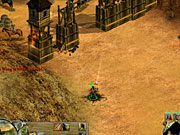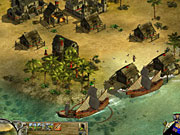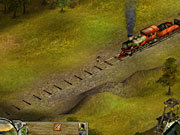No Man's Land is CDV's latest offering from a crop of real-time strategy games developed in Europe and later released in the US. The company's titles tend to be relatively realistic and historically-based, and No Man's Land appears to be no exception, at first glance. The various factions and artwork are reflective of the 17th, 18th, and 19th centuries, but, in fact, there's a lot of mysticism and historical inaccuracy in the game. This results in placing the game in its own "no man's land" between historical authenticity and fiction. Additionally, it falls victim to lackluster gameplay, thus preventing it from being recommendable to RTS fans.

No Man's Land takes place in North America from the 1600s to the 1900s. There are six factions in the game, including Native Americans, Europeans, and American settlers. There are three campaigns in the single-player mode, but they don't follow any kind of chronological order. Instead, the campaigns show how various factions were related to one another. The first campaign follows a Spanish man as he investigates a sudden drop in gold production in the New World. You'll end up in the Caribbean fighting some familiar foes of Spain during the time period. Next, you'll play as the Iroquois Indians, who are fighting for survival in their woodland homes during the founding of the American colonies. When you finish this set of missions, a character explains that other Indians are having problems with the "pale faces." You then jump to playing prairie Indians who are fighting the settlers in the Midwest as they arrive on trains. The third campaign starts with the English arriving in America on the Mayflower, which, if you recall from history, arrived in 1620. It's being escorted by warships, and they come under fire from...the Spanish? Interestingly, the Mayflower was a religious voyage, not a military one, and the Spanish never even made it that far north. Anyway...
As you can imagine, No Man's Land isn't going to replace your history text. The story varies from being somewhat believable to just plain ridiculous. To give another example, in the first campaign you're fighting someone named Drake. This is plausible because Sir Francis Drake attacked Spanish ships for the English crown. Oddly, you then you encounter an Indian shaman who can summon animals from out of thin air! The game just feels trapped between trying to adhere to reality and making copious use of creative license to the point where the proceedings just make no sense.
Each of the six factions has its own unique buildings and units, although these units are all functionally equivalent. There are weak combat units, stronger but more expensive fighters, and units with bonuses against cavalry. Depending on the faction, these units feature ranged or melee attacks. The cavalry is also composed of the three described infantry units, but, in contrast, the cavalry units are merely--and obviously--on horseback. The European nations can also build cannons and warships, while the Native American tribes are limited to canoes. As you might have guessed, there really isn't much variety to the game's military might, so, in turn there isn't much strategy in the game. Battles are won through sheer force rather than tactical decisions. All you really need is a big group of the weak fighters to be fodder for a big group of the strong fighters.

The main differences between factions are the elite units, which are the game's version of heroes. They are units built from special structures. Some of them are story-specific characters, but they are all are much stronger than the standard units. They have increased hit points, stronger attacks, and special abilities, and they can regenerate hit points. Some of their special abilities include being able to instantly kill other units or being able to cast whirlwind magic that inflicts heavy damage on buildings. Some of the heroes can be obscenely overpowered to the point where you can solve campaign missions with just the hero unit alone if you are patient enough to let it heal.
However, most of the time your heroes will die because they'll run themselves into an enemy base due to the game's poor artificial intelligence. There are behavioral settings for units, but there are some problems with these settings. The aggressive setting is fine, as it will cause your unit to actively hunt down enemies that come within a specific range. The hold position setting is also fine because sometimes you want your units to fire from a given spot. The problem lies with the defensive position. In most RTS games, a defensive-minded behavioral unit will move to attack a unit that comes within its range before returning to its original spot. In No Man's Land, units placed on a defensive setting will only attack an enemy if they are, themselves, attacked. So, if a group of riflemen are set to "defensive," they will not attack an Indian spearman if he is attacking only one of the riflemen. This behavioral setting is, therefore, practically worthless, so you can either pull your hair out because your units blindly run into an enemy base, or you can pull your hair out because your units won't track down an enemy because they are set to "hold position."
The enemy AI is also easy to fool because it will typically target the closest unit. A good tactic to use against the computer is to parade your elite unit in the front lines to draw enemy fire while your troops do the real damage. The computer also won't put up much of a fight in the campaigns. It will throw some squads at your base, but it's nothing that a few towers with support can't handle. Missions can become boring as you continually slog through enemy defenses to complete objectives.

The economy has flaws as well. There are three resources: food, wood, and gold. The problem is that all units and upgrades require food, which is not an infinite resource in No Man's Land. Farms have to be built on fertile land that has a preset number of food units. If you run low on food, the game comes to a screeching halt. The pacing will become really slow unless you find another fertile field or other animals to hunt. You can trade other resources to acquire food, but wood is the only plentiful resource, and you need a lot of it to make trades. There are two types of workers: male and female. They both construct and gather resources, but the males cost more food and have a better attack rating. You'll probably end up recruiting females because food is precious--and the game is pretty much over if you have to resort to fighting with peasants.
No Man's Land is an appropriate moniker for the game's multiplayer mode. There is no in-game browser to find servers, and there are absolutely no games being played from what we saw using third-party server browsers. It's hard to call this a disappointment because the game isn't easily recommended to begin with, but the multiplayer mode, in theory, is fleshed-out nicely. There are your typical RTS build-and-fight-to-the-death modes, but there are also some other familiar game types, like king of the hill and unit elimination. No Man's Land also has a unique gameplay mode called railroad race where you have to complete a railroad across the map before your opponents complete their own. Things can get really interesting when your tracks intersect those of your opponents, thus leading to some brutal fights for track completion.
Fortunately, you don't need human opponents to play these modes because you can enter a skirmish against the computer. You can set difficulty ratings for the computer AI, making it relatively more or less challenging. The computer puts up much more of a challenge in skirmish than in the campaigns, so be prepared to actually have to work. There are some interesting additions to the RTS formula in these modes. First, there are assassins you can hire. If you're having problems with an enemy's elite unit, just hire one of these assassins to eliminate him. However, you can be outbid by other players, so, you might see the assassin as he comes after your elite unit instead. You can also purchase "upgrades" that affect your opponent. They can temporarily cause detrimental effects, like slowing workers' production or reducing enemy unit hit points. These aren't going to revolutionize the RTS, but they add a nice twist to the formula.
Like the gameplay, the graphics in No Man's Land are hit-or-miss. The environments are detailed nicely and look appropriate for each scenario. The water has a shimmering effect, and explosions tear through the air. The units and buildings look good when static, but some unit animations can be noticeably lacking. For example, Grass Wing's throwing knife often appears to come from a few feet above his head instead of from his hand. Of further note, most of the cutscenes are handled by the game's engine, so it does a decent job of progressing the campaigns.

The cutscenes are also where you'll find another disappointing aspect of the game: the sound. The voices, in particular, are just plain awful. It's clear from the dull lines that little effort was put into the voice work for the characters. Unit acknowledgements are equally poor. Some effects, like gunfire, do produce some nice booms, and the soundtrack isn't that bad.
No Man's Land flip-flops constantly. Sometimes it can be fun, and at other times it's incredibly tedious. The storylines for each campaign run from forgettable to absurd. The AI is rather poor, and some factions are missing features. For instance; the manual states that there are unit formations for European factions, but it doesn't tell you how to use them, and there aren't any menu commands for them. You also can't rotate the camera as mentioned in the manual. The end result is that No Man's Land isn't worth the trip.